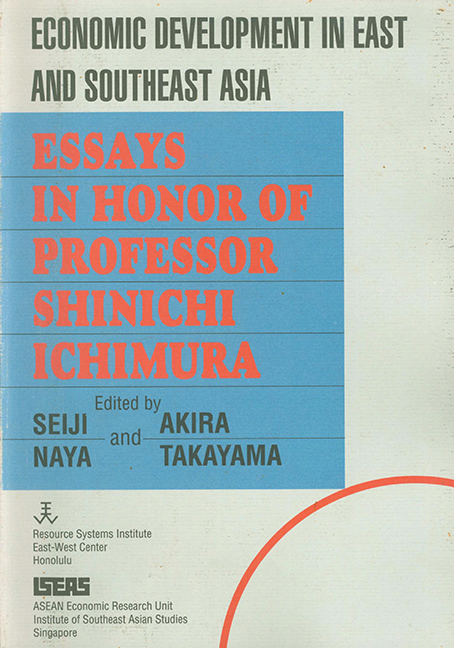Book contents
- Frontmatter
- Preface
- Shinichi Ichimura, 1925-
- CONTENTS
- Introduction
- Contributors to This Volume
- I Structural Change and Economic Development in Developing Asia in the 1990s
- II Explaining the Success of the Four Little Dragons: A Survey
- III Taiwan's Economic Miracle: A Singaporean Perspective
- IV Singapore's Experience of Industrial Restructuring: Lessons for the Other Asian NIEs
- V Korean Industrial Policies for Declining Industries
- VI Vietnam: Recent Economic Developments and the World Economy
- VII Transition from Import Substitution to Export Expansion: The Thai Experience
- VIII Adjustment Problems of a Small Oil-Exporting Country: Did Indonesia Suffer from the Dutch Disease?
- IX A Quarterly Econometric Model of the Hong Kong Economy
- X The Effect ofRicardian Rent Extracting on Macroeconomic Performance
- XI Direct Foreign Investment and the Economic Development of Korea
- XII Japanese Investment in Thailand: Looking Back and Into the Future
- XIII The Effects of Direct Foreign Investment on Taiwan: A Macroeconometric Investigation
- XIV A Reform of the Foward Foreign Exchange Market and Foreign Exchange Rate Determination Policy in Korea, with Foreign Exchange Policy Experiences of Taiwan
- XV Interest Rate and Foreign Exchange Liberalization in Taiwan in the 1980
- XVI Manifold Dilemmas behind External Debt Management
- XVII Agricultural Growth and Food Imports in Developing Countries: A Reexamination
- XVIII The Transformation of Rural Asia and Economic Development Theory and Policy
- XIX The ASEAN Summit and ASEAN Economic Cooperation
- XX The Role of Developing Countries in the New GATT Round
- XXI The Emerging Global Economy and the Role of the Asian NIEs
- Index
XI - Direct Foreign Investment and the Economic Development of Korea
Published online by Cambridge University Press: 21 October 2015
- Frontmatter
- Preface
- Shinichi Ichimura, 1925-
- CONTENTS
- Introduction
- Contributors to This Volume
- I Structural Change and Economic Development in Developing Asia in the 1990s
- II Explaining the Success of the Four Little Dragons: A Survey
- III Taiwan's Economic Miracle: A Singaporean Perspective
- IV Singapore's Experience of Industrial Restructuring: Lessons for the Other Asian NIEs
- V Korean Industrial Policies for Declining Industries
- VI Vietnam: Recent Economic Developments and the World Economy
- VII Transition from Import Substitution to Export Expansion: The Thai Experience
- VIII Adjustment Problems of a Small Oil-Exporting Country: Did Indonesia Suffer from the Dutch Disease?
- IX A Quarterly Econometric Model of the Hong Kong Economy
- X The Effect ofRicardian Rent Extracting on Macroeconomic Performance
- XI Direct Foreign Investment and the Economic Development of Korea
- XII Japanese Investment in Thailand: Looking Back and Into the Future
- XIII The Effects of Direct Foreign Investment on Taiwan: A Macroeconometric Investigation
- XIV A Reform of the Foward Foreign Exchange Market and Foreign Exchange Rate Determination Policy in Korea, with Foreign Exchange Policy Experiences of Taiwan
- XV Interest Rate and Foreign Exchange Liberalization in Taiwan in the 1980
- XVI Manifold Dilemmas behind External Debt Management
- XVII Agricultural Growth and Food Imports in Developing Countries: A Reexamination
- XVIII The Transformation of Rural Asia and Economic Development Theory and Policy
- XIX The ASEAN Summit and ASEAN Economic Cooperation
- XX The Role of Developing Countries in the New GATT Round
- XXI The Emerging Global Economy and the Role of the Asian NIEs
- Index
Summary
Introduction
It is now widely accepted that Korea's economic success during the past three decades was due to, inter alia, the adoption of an outward-oriented development strategy (Lee and Naya 1988). This outward-oriented development strategy can be characterized by the following four principles: 1) Preferential treatment of manufacturing activities, where warranted for infant-industry considerations, is applied on a moderate scale; 2) Equal treatment is given to exports and import substitutes in manufacturing; 3) Variation in incentives within manufacturing is kept to a minimum; and 4) The system of incentives is stable and automatic to minimize uncertainty (Balassa 1980,1981). By adopting an outward-oriented development strategy based on these principles, Korea was able to expand its exports rapidly and to transform itself from an agrarian economy into a manufacturing exporter in a short period of time.
In contrast, Korea maintained a restrictive direct foreign investment (DFI) policy until the middle of the 1980s; consequently, its effect cannot be described as having been neutral in terms of resource allocation. The restrictive foreign investment policy limited the amount of investment and the industries in which investment could be made, and, in terms of resource allocation, it resembled Korea's restrictive financial policy rather than its trade policy.
This paper examines and evaluates Korea's DFI policy and attempts to answer the following questions: What has been Korea's policy on DFI in the past three decades? What has been the effect of DFI on its economic development? And has the policy been equivalent to the outward-oriented development strategy in terms of the effect on resource allocation and been consistent with it in terms of the policy objectives? To this end, the pattern and trends of DFI in Korea are presented, and its overall importance to the economy is examined. This paper will also discuss and evaluate Korea's DFI policy in terms of the effect of DFI on the Korean economy.
Pattern and Trend of DFI in Korea
DFI in Korea began in 1962 with a joint venture established by an American textile company producing nylon filaments (table 1). Over the next five years (1962-66), investment projects involving $47.4 million and 39 firms were approved, while the actual investment amounted to $24.3 million (51 percent of the approved amount).
- Type
- Chapter
- Information
- Economic Development in East and Southeast AsiaEssays in Honor of Professor Shinichi Ichimura, pp. 169 - 184Publisher: ISEAS–Yusof Ishak InstitutePrint publication year: 1990



